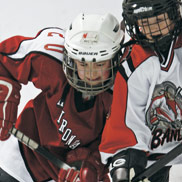Body Checking In Youth Hockey Causes More Brain Injuries
/
Youth hockey players in the Atom division of Hockey Canada are more than 10 times likely to suffer a brain injury since bodychecking was first allowed among the 9 and 10-year-olds, says a study led by St. Michael's Hospital neurosurgeon Dr. Michael Cusimano.
The findings, published online in the journal Open Medicine, add to the growing evidence that bodychecking holds greater risk than benefit for youth and support widespread calls to ban the practice.
According to the researchers, led by Cusimano, director of the Injury Prevention Research Centre at St. Michael's Hospital in Toronto, the odds of visiting an emergency department due to a brain injury from bodychecking increased significantly among all minor hockey players after Hockey Canada relaxed bodychecking rules in the 1998/1999 season. At that time, the organization allowed, for the first time, body contact among 9 and 10 year-olds in the Atom division.
The team examined the records of 8,552 male youth 6-17 years-old who attended one of five emergency departments in Ontario for hockey related injuries that occurred before and after the rule change. Researchers found more than half of hockey-related injuries were a result of bodychecking. What's more, the risk of a head or neck injury, including concussions, increased across all minor hockey divisions.
"Our work confirmed the fact that body checking is the most common cause of injury in hockey. While proponents argue lowering the age for bodychecking helps players learn how to properly bodycheck and reduces injuries at older ages, our study clearly showed the opposite ― the risk of all injuries and especially, brain injuries, increases with exposure to bodychecking," Cusimano said. "While all age groups showed increases in injuries, the youngest were the most vulnerable and that bodychecking puts youth unnecessarily at the risk of the long-term effects of brain injuries, such as cognitive and social-behavioural problems."
For some time, researchers like Dr. Cusimano have called on organizations like the NHL to take more leadership in reducing the incidence of brain injuries. In recent weeks, pressure has mounted on the NHL after Pittsburgh Penquins captain Sidney Crosby and Montreal Canadiens' Max Pacioretty suffered serious concussions that sidelined both players.
"Ice hockey is a sport with great potential to increase the health of individuals but practices that increase the risk for the vast majority of players must be minimized," Cusimano adds. "It is now very clear that there is no benefit to any one or any group to continue to allow bodychecking. Hockey organizers, sponsors, the media, coaches, trainers, and players and parents must come together to advocate for multifaceted approaches that include changes to the rules to reduce the risk of injury."
Source: St. Michael's Hospital and Michael D Cusimano, Nathan A Taback, Steven R McFaull, Ryan Hodgins, Tsegaye M Bekele, Nada Elfeki; Canadian Research Team in Traumatic Brain Injury and Violence. Effect of bodychecking on rate of injuries among minor hockey players. Open Medicine, Vol 5, No 1 (2011)
See also: New Return-To-Play Guidelines For Sports Concussions and Youth Sports Concussions Double In Last Ten Years
The findings, published online in the journal Open Medicine, add to the growing evidence that bodychecking holds greater risk than benefit for youth and support widespread calls to ban the practice.
According to the researchers, led by Cusimano, director of the Injury Prevention Research Centre at St. Michael's Hospital in Toronto, the odds of visiting an emergency department due to a brain injury from bodychecking increased significantly among all minor hockey players after Hockey Canada relaxed bodychecking rules in the 1998/1999 season. At that time, the organization allowed, for the first time, body contact among 9 and 10 year-olds in the Atom division.
The team examined the records of 8,552 male youth 6-17 years-old who attended one of five emergency departments in Ontario for hockey related injuries that occurred before and after the rule change. Researchers found more than half of hockey-related injuries were a result of bodychecking. What's more, the risk of a head or neck injury, including concussions, increased across all minor hockey divisions.
"Our work confirmed the fact that body checking is the most common cause of injury in hockey. While proponents argue lowering the age for bodychecking helps players learn how to properly bodycheck and reduces injuries at older ages, our study clearly showed the opposite ― the risk of all injuries and especially, brain injuries, increases with exposure to bodychecking," Cusimano said. "While all age groups showed increases in injuries, the youngest were the most vulnerable and that bodychecking puts youth unnecessarily at the risk of the long-term effects of brain injuries, such as cognitive and social-behavioural problems."
For some time, researchers like Dr. Cusimano have called on organizations like the NHL to take more leadership in reducing the incidence of brain injuries. In recent weeks, pressure has mounted on the NHL after Pittsburgh Penquins captain Sidney Crosby and Montreal Canadiens' Max Pacioretty suffered serious concussions that sidelined both players.
"Ice hockey is a sport with great potential to increase the health of individuals but practices that increase the risk for the vast majority of players must be minimized," Cusimano adds. "It is now very clear that there is no benefit to any one or any group to continue to allow bodychecking. Hockey organizers, sponsors, the media, coaches, trainers, and players and parents must come together to advocate for multifaceted approaches that include changes to the rules to reduce the risk of injury."
Source: St. Michael's Hospital and Michael D Cusimano, Nathan A Taback, Steven R McFaull, Ryan Hodgins, Tsegaye M Bekele, Nada Elfeki; Canadian Research Team in Traumatic Brain Injury and Violence. Effect of bodychecking on rate of injuries among minor hockey players. Open Medicine, Vol 5, No 1 (2011)
See also: New Return-To-Play Guidelines For Sports Concussions and Youth Sports Concussions Double In Last Ten Years

















